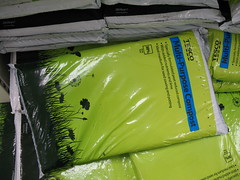- in Gardening by Alexis Rodrigo
Peat-Free Compost: An Earth-Friendlier Option
If you have a garden, you probably use compost. If you buy that compost from a store, it may be made entirely of peat or contain peat. In fact, some gardeners prefer pure peat to compost their soil. If you garden, you are probably a lover of nature and the earth, so it might be worthwhile to note that peat compost is not particularly earth-friendly.
What is peat?
[ad#ad-2] Under certain conditions – such as in wetlands and bogs – rotting vegetation (particularly sphagnum moss) accumulates and, due to inhibitions in the decay process, the vegetation rots only partially and forms peat. There are higher concentrations of peat bogs in the northern than in the southern hemisphere.Peat is acidic, which accounts for its use as a compost medium. It is used as fuel in some areas of the world, particularly Ireland and Scotland, where trees tend to be scarce. To make compost, peat is harvested from wetlands and processed to form the peat you find in bags at the garden center.
Why is peat compost a problem?
- Wildlife
One of the concerns about peat is the destruction of the wetland that occurs when it is harvested. Wildlife such as birds, dragonflies, and butterflies depend on the peat for survival. Rare plants that occur only in wetlands, such as certain mosses and bog myrtle, are destroyed in the harvesting process.
- Carbon
When peat is left in its natural state, its carbon is “locked.” When it is harvested and allowed to decompose as compost, it releases carbon dioxide. This is a concern for those who want to reduce carbon emissions.
- Unsustainability
Peat bogs form at approximately 1 millimeter a year. They are mined at a much faster rate than that, making peat an unsustainable choice for compost. The hand-cutting of peat for fuel, which has occurred for centuries, is a slow process and does not take the same toll on the wetland as the mechanized, mass harvesting that is necessary to keep up with the demand for garden compost.
Are there alternatives?
Thankfully, there are alternatives. Peat-free compost is available in stores, and of course, you can make your own compost at home. Commercial peat-free compost is made from plant matter that would normally be wasted (such as forestry cuttings), and is finely shredded and decomposed in large piles. This cuts down on the amount of organic waste that would be sent to the landfill. It is not necessarily more expensive, either.
The realization that peat harvesting is not an earth-friendly practice may inspire you to start your own compost pile. Share it with your neighbors and reduce everyone’s dependence on peat.
![]() photo credit: hapticflapjack
photo credit: hapticflapjack
If you liked this post, submit your email address below to get new posts by email:

